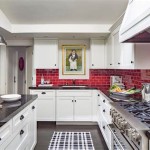How to Stain Kitchen Cabinets Darker
Staining kitchen cabinets a darker color can dramatically transform the look and feel of a kitchen without the expense of a full replacement. This process, while manageable for a seasoned DIY enthusiast, requires meticulous preparation, careful application, and a thorough understanding of the materials involved. This article provides a comprehensive guide to achieving a professional-looking darker stain on kitchen cabinets.
Before commencing any staining project, it is critical to assess the current condition of the cabinets. Examine the existing finish, noting whether it is varnish, paint, or a previous stain. Identify any areas with damage, such as scratches, dents, or peeling finish. Understanding the existing condition will dictate the necessary preparatory steps.
Furthermore, consider the type of wood your cabinets are made of. Different wood species absorb stain differently. For instance, softer woods like pine tend to absorb stain unevenly, requiring preemptive use of wood conditioner. Harder woods, such as maple or oak, often require more aggressive sanding to open the pores and allow for proper stain penetration.
Key Point 1: Thorough Preparation is Paramount
The success of any cabinet staining project hinges on the thoroughness of the preparation phase. Inadequate preparation can result in an uneven finish, poor stain adhesion, and ultimately, a less-than-desirable outcome. This phase encompasses cleaning, stripping, sanding, and potentially applying a wood conditioner.
Begin by removing all hardware, including knobs, pulls, hinges, and any decorative elements. Label each piece and its corresponding location to ensure easy reassembly later. Store the hardware in a safe place to prevent loss or damage.
Next, thoroughly clean the cabinets to remove grease, grime, and any other contaminants. Use a degreasing cleaner specifically designed for kitchen surfaces. Trisodium phosphate (TSP) is a powerful cleaner, but it requires careful handling and adherence to safety precautions. Alternatively, a milder solution of dish soap and warm water can be used. Rinse the cabinets thoroughly with clean water and allow them to dry completely.
Stripping the existing finish is often necessary, particularly if the current finish is thick, glossy, or peeling. Chemical strippers are effective for removing old finishes, but they require adequate ventilation and the use of personal protective equipment, including gloves and eye protection. Apply the stripper according to the manufacturer's instructions and allow it to dwell for the recommended time. Scrape off the softened finish with a plastic scraper, being careful not to gouge the wood. Multiple applications of stripper may be necessary for stubborn finishes.
Once the majority of the old finish is removed, sanding is essential to create a smooth, uniform surface for the new stain. Begin with a coarser grit sandpaper (e.g., 120-grit) to remove any remaining finish and imperfections. Progress to finer grits (e.g., 180-grit, then 220-grit) to refine the surface. Sand with the grain of the wood to avoid creating scratches. Use a palm sander for larger, flat surfaces and a sanding block or detail sander for corners and intricate areas. After sanding, thoroughly remove all dust with a tack cloth or vacuum cleaner.
If working with a soft wood species, consider applying a wood conditioner before staining. Wood conditioner helps to even out the absorption of the stain, preventing blotchiness and ensuring a more consistent color. Apply the conditioner according to the manufacturer's instructions and allow it to dry completely before proceeding with the staining process.
Key Point 2: Selecting and Applying the Stain
Choosing the right stain is crucial for achieving the desired aesthetic. Stain comes in various formulations, including oil-based, water-based, and gel stains. Oil-based stains penetrate the wood deeply, providing a rich, durable finish. However, they have a strong odor and require mineral spirits for cleanup. Water-based stains are lower in odor and clean up with water, but they may not penetrate as deeply as oil-based stains. Gel stains are thicker and ideal for use on vertical surfaces or non-porous materials, such as veneer or fiberglass.
When selecting a stain color, it is recommended to test it on an inconspicuous area of the cabinet or on a scrap piece of wood of the same species. This will allow you to visualize the final color and determine if it meets your expectations. Consider the undertones of the stain and how they will complement the existing colors in your kitchen.
Before applying the stain, stir it thoroughly to ensure that the pigments are evenly distributed. Apply the stain in thin, even coats using a brush, rag, or foam applicator. Work with the grain of the wood and avoid applying too much stain in one area. Allow the stain to dwell for the recommended time, as specified by the manufacturer. The longer the stain dwells, the darker the color will be.
After the dwell time, wipe off the excess stain with a clean, lint-free rag. Use a firm, even pressure to remove the stain and reveal the grain of the wood. If the color is not dark enough, apply a second coat of stain, following the same procedure. Allow the stain to dry completely before proceeding to the next step.
Key Point 3: Sealing and Protecting the Finish
Once the stain has dried completely, it is essential to seal and protect the finish with a clear topcoat. A topcoat will provide a durable barrier against moisture, scratches, and other forms of damage. Choose a topcoat that is compatible with the stain you have used. Common topcoat options include polyurethane, varnish, and lacquer.
Polyurethane is a popular choice for kitchen cabinets due to its durability and water resistance. It is available in oil-based and water-based formulations. Oil-based polyurethane provides a slightly warmer tone and is more durable, but it has a strong odor and requires mineral spirits for cleanup. Water-based polyurethane is lower in odor and cleans up with water, but it may not be as durable as oil-based polyurethane.
Varnish is another durable option that provides a protective layer against moisture and scratches. It is available in various sheens, from matte to gloss. Lacquer is a fast-drying finish that provides a smooth, durable surface. However, it is more brittle than polyurethane and varnish and may be more prone to cracking or chipping. Lacquer also requires specialized spraying equipment for application.
Apply the topcoat in thin, even coats using a brush, roller, or sprayer. Work with the grain of the wood and avoid applying too much topcoat in one area. Allow the topcoat to dry completely between coats, as specified by the manufacturer. Lightly sand between coats with fine-grit sandpaper (e.g., 320-grit) to remove any imperfections and ensure a smooth finish. Apply at least two coats of topcoat for adequate protection. For high-use areas, such as around the sink or stove, consider applying three or more coats.
Once the final coat of topcoat has dried completely, carefully reinstall the hardware. Be sure to align the hardware properly and tighten the screws securely. Clean the cabinets with a mild soap and water solution to remove any dust or fingerprints. Allow the cabinets to cure for several days before placing items back inside. This will allow the finish to fully harden and prevent damage.
Maintaining the newly stained cabinets involves regular cleaning with a mild soap and water solution. Avoid using harsh chemicals or abrasive cleaners, as these can damage the finish. Wipe up spills promptly to prevent staining. Periodically inspect the cabinets for any signs of damage and address them promptly. Applying a fresh coat of topcoat every few years can help to maintain the beauty and durability of the finish.

Staining Your Wood Cabinets Darker Young House Love

How To Stain Wood Cabinets True Value

5 Ideas How To Update Oak Or Wood Kitchen Cabinets Part 1 Staining

How To Stain Oak Cabinetry Tutorial The Kim Six Fix

Diy Staining Oak Cabinets Eclectic Spark

Gray Stain Kitchen Cabinet Design

Painted Wood Cabinets Vs Stained A Questionnaire Kylie M Interiors

How To Refinish Wood Cabinets The Easy Way Love Remodeled

Staining Your Wood Cabinets Darker Young House Love

How To Stain Dark Or Yellow Kitchen Cabinets Lighter








